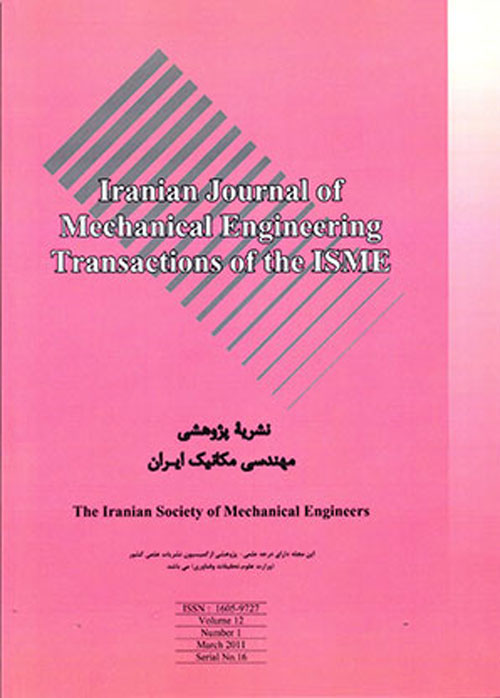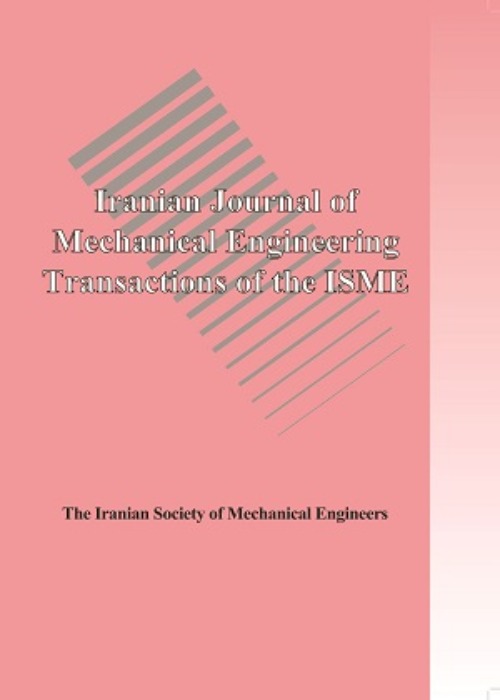فهرست مطالب

Iranian Journal of Mechanical Engineering Transactions of ISME
Volume:16 Issue: 2, Sep 2015
- تاریخ انتشار: 1395/12/15
- تعداد عناوین: 6
-
-
Page 5Thermo-Elasto-Plastic analyses of thick-walled spherical tanks made of functionally graded materials (FGM) are investigated analytically. These tanks are subjected to positive or negative temperature gradient and internal pressure loadings, separately or simultaneously. The power law modeling has been used for considering the throughthickness variation of mechanical properties. von Mises yield criterion and Elastic-Perfectly-Plastic assumptions are used for describing the material behavior in plastic zones. The patterns of plastic zones spreading for various combinations of internal pressure and positive or negative temperature gradient are investigated. Conducting numerical exercises for similar problems in ABAQUS software shows the excellent agreement with the analytical solutions. FG sphere subjected to internal pressure and negative temperature gradient yields at a lower pressure than the FG sphere subjected to internal pressure. Internal pressure and negative temperature gradient combination is the most critical loading combination. Moreover, the results show that the capacity of FG spherical tank subjected to internal pressure is increased by applying a positive temperature gradient.Keywords: Analytical analyses, Thermo, Elasto, Plastic stresses, Functionally graded spherical reservoir, Temperature gradient, Internal pressure
-
Page 26This paper aims to investigate a new and intricate behavior of immediate follower during the lane change of leader vehicle. Accordingly, the mentioned situation is a tran ** sient state in car following behavior during which the follower vehicle considerably deviates from conventional car following models for a limited time, which is a complex state including lateral and longitudinal movement simultaneously. Based on closer inspection of microstructure behavior of real drivers, this transient state is divided into two stages of anticipation and evaluation. Afterwards, a novel adaptive neuro-fuzzy model considering human driving factors is proposed to simulate the behavior of real drivers. Comparison of model results and real traffic data shows that the proposed model can describe anticipation and evaluation behavior during a car following behavior with acceptable errors which leads to enhancement of car following applications like driving assistant and collision avoidance systems.Keywords: evaluation, car following, intelligent model, ANFIS, human driving factors
-
Page 39In this paper, an analytical solution for computing the linear plastic stresses, critical temperature and pressure in an FGM hollow cylinder under the internal pressure and temperature is developed. It has been assumed that the modulus of elasticity and thermal coefficient of expansion were varying through thickness of the FGM material according to a power law relationship. The Poisson''s ratio was considered constant throughout the thickness. The general forms of thermal and mechanical boundary conditions were considered on the inner surface. In the analysis section, the effect of nonhomogeneity in FGM cylinder was implemented by choosing a dimensionless parameter, named m, which could be assigned an arbitrary value affecting the stresses in the cylinder. Distribution of stresses in radial and circumferential direction for FGM cylinders under the influence of internal pressure and temperature gradient were obtained. Graphs of critical temperature and pressure versus radius of the cylinder were plotted. Cases of pressure and temperature loadings were considered separately. The direct method has been considered to solve the heat conduction and Navier equations. The outer pressure for all over the cylinder goes to the plastic region when ===0 and by increasing the modules of elasticity the pressure will increase. By substituting M=0 in radial linear plastic stress formula, the perfect plastic equation will yield. By putting , 0 pp rr rr r єє in radial linear plastic stress formula, it turns to the radial elastic stress.Keywords: Hollow cylinder, non, homogenous, axisymmetric, FGM, Elastic, Plastic Analysis
-
Page 66Microstructure, tensile properties and fracture energy of a friction stir spot welded polycarbonate (FSSW) were studied at varying rotational rates and dwelling times. The problem of common FSSW welding is the remaining of characteristic keyhole. This can act as a concentration place in mechanical tests. To order solve this problem authors took advantage of innovation for designing the welding tool. The results show that in constant dwell time, strength increases until 800 rpm and then decreases. In constant rotational speed (400, 800) the strength increases by increasing in dwell time but in 1600 rpm the best result was achieved in 10 Sec dwell time. Fractures energy which was exploit from stress-strain curve were in good agreement with strength of welds.Keywords: Friction stir spot welding, Polycarbonate, Tensile strength, Tool without pin, characteristics keyhole
-
Page 77A FGM layer sandwiched between two isotropic layers weakened by several interface cracks under antiplane loading is studied. This paper examines the modelling of cracks by distribution of strain nuclei along crack lines. In this investigation, the Volterra-type screw dislocation employed between FGM and an elastic layer. To solve the dislocation problem, the complex Fourier transform is applied. One merit of this technique is the possibility to determination of the stress intensity factors for multiple cracks. The system of equations is derived by considering the distribution of line dislocation on the crack. These equations are of Cauchy singular type at the location of dislocation, which can be solved numerically to obtain the dislocation density on the faces of the cracks. Several examples are solved and the stress intensity factors are obtained. The effect of the properties and cracks geometries on the mode III stress intensity factor are studied and the validity of analysis is checked.Keywords: Multiple interface cracks, Functionallay graded layer, Singular integral equations, Stress intensity factors, Distributed dislocation tecchnique


